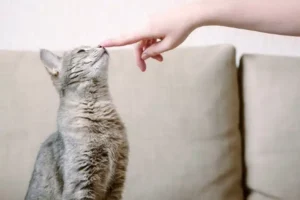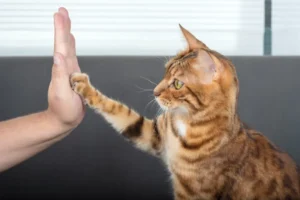
The second myth that most people use is that cats are too independent or unapproachable to train…
The second myth that most people use is that cats are too independent or unapproachable to train, like dogs, and this is much to the detriment of their true nature, the intelligence, and the personality of the cat. Although dogs usually want to please their masters, they are naturally inclined to be trained and obey, cats have another form of cognitive complexity; they like to show their curiosity, subtle communication, and independence. Cats are more like equal partners in the learning process rather than a subordinate as compared to dogs, who are better off with social hierarchy and obedience. This does not make them any lesser learners, but, instead, it just requires a re-imagined learning model driven by compassion and tolerance. The second thing is to grasp the nature of this contrast: this is not about domination and submission, it is about trust, respect, and motivation.
And why is it then so hard to train a cat as compared to a dog?
A big cause is in evolutionary and social frameworks. Canines also belong to a pack and understand selective leadership which makes them more submissive to commands and authorities. The cats on the other hand were hunters who developed to be quite solitary. They lack a case of following a lead leader in their instinct which makes them less tolerant of authoritarian training styles. Also, whereas dogs can visibly indicate excitement, nervousness or concentration, cats conceal their moods under their composures hence it becomes difficult to tell whether the trainers are connecting with the cat or not. Such subtlety needs the trainers to monitor such micro signals as twitching of the ears or tail flicks. And then there is attention span, as a dog can be trained 15 minutes straight, cats are easily trained in several short sessions and then they lose interest and go do their own thing. The above issues do not mean that one cannot train their feline pet, but they only mean that we have to change our approach to correspond to their rhythm and character.

Although cats are taught numerous behaviors through reward-based training that attracts the myths…
However, whether it is the traditional commands such as the sit, high-five, or the more complicated behaviors such as leash-walking, object retrieving process, cats prove to be clever students despite the normal level of expectation. They are even trained to appear when whistled or to perform agility competitive course like obstacle courses. The thing is not only about the content of the training, but about the method and the timing. Younger cats, more sociable cats and more playful ones are likely to learn quicker, although the more reserved and older cats may be very successful with the right tactic. To use the example of a Bengal cat, since these animals are highly active, learning to walk on a leash might come easily to them, whereas a leisurely Persian may require extra encouragement but will possibly learn to do a paw shake eventually. Instead of making goals the same, the trick is to use them to meet individual cat preferences and and abilities.
The equipment is also necessary in training especially on certain activities such as leash walking.
Harness that is comfortable, flexible enough but secure enough is important. Not all the products focus on just the style or only the function, such as velvet-lined, escape-proof harness and leash sets which can make a cat feel good and make the owner feel good about them. Such tools do not just allow walks to be possible but also develop some positive memories related to training. Still, approach is much more important than accessories in terms of training success. A very adaptable harness can be useful but it is the continual positive encouragement that makes habit sticks. Assuming the cat does not turn training into a stressful endeavor, he/she will more likely like it and repeated it. Other brands such as Hepper have come up with feline safe training equipment, but simple tools can still work, provided that they are used empathetically and consistently.

Naturally not every cat can be equally trainable.
Much depends on breed differences, temperament, intelligence and even past experiences. As an example, outgoing cats, such as Siamese, might be excited to participate in interactive commands, but a Scottish Fold can require more moderate activities that are less vociferous. Moreover, kittens usually emulate better into training because their opinion of the world is still being developed. Otherwise, adult/senior cats may be more suspicious, and they need additional time and patience. The degree of interest a cat may have towards training is also dependent on the relationship it has with its owner in most cases. The cat which is not suspicious will react kindly, no matter what kind and how old is. The question should then not be, can my cat be trained but, how can I create the trust and environment that my cat needs and can perceive so that he will be willing to learn.
Any individual willing to take up the challenge of cat rearing…
…following the rewarding course of developing a cat can be simplified by a couple of general principles. Firstly, it is crucial to be patient and have a real expectations. It can only take one afternoon to train a dog but possibly a series of sessions over weeks to train a cat. Cats also learn independently and they may suddenly seem to make progress after it seems they are hardly getting anywhere. It can be beneficial even in case when the first sessions do not show any outcomes, consistency and calmness tend to clear the road to breakthroughs. The achievement with cats is not as much a matter of velocity; it is more a matter of comprehension. Take anything at all, the slightest movement of the ear, the slightest movement of a paw, as a step forward.
Early confidence can be developed using behaviors that tally with natural instincts of your cat.
An example, for instance, when your cat is habitually reaching or tapping, use that to your advantage, by showing it how to high-five or do the paw-shakes. In case your cat prefers chasing, the training methods of fetch gaming may seem straightforward. Utilizing the phenomena of the pre-existing behaviors will decrease resistance and serve to decrease the mental load of the cat so that they can associate actions with rewards more naturally. After those basic-behaviors are taught, the trainers can then move gradually to less instinctive behavior. The expansion of the comfortable to the new anticipates the scaffolding of human learning itself catered as we do crawling and then walking, words and sentences and so on.

This is because reinforcement especially on the part of food remains an important pillar on cat training success.
However, not all rewarding is alike. It is advised to apply the high-value, special treats your cat will never receive when not training. Such exclusivity increases motivation, and training sessions become more appealing. As an example freeze dried chicken or tiny pieces of tuna is usually more of an attention grabber than a dry kibble. As a means of preventing overfeeding, treats should not exceed 10 percent of the daily calorie intake of a cat. Even some owners will incorporate part of regular meal and some parts during training time – giving regular sized kibble between meal between treats in reward scale. This helps maintain a high level of motivation and encourage diet moderation. It is important to note that engagement can be increased using a behavioral psychology principle, the view of variable rewards, the combination of treat size and frequency.
Ultimately training a cat is not about obedience but communication.
It is about finding out what encourages your feline, how it is interested in something and changing your approach to this. When cats are treated as individual (and different) beings and not as miniature dogs, they can be more easily trained, sometimes even as much as dogs. A high-five or a recall cue goes a long way before it turns into a deeper connection, as one catches up what the other knows and nurtures mutual respect. Instead of imposing human desires on the animal behavior, training of cats flourishes with the help of curiosity, adaptability, and above all love.

